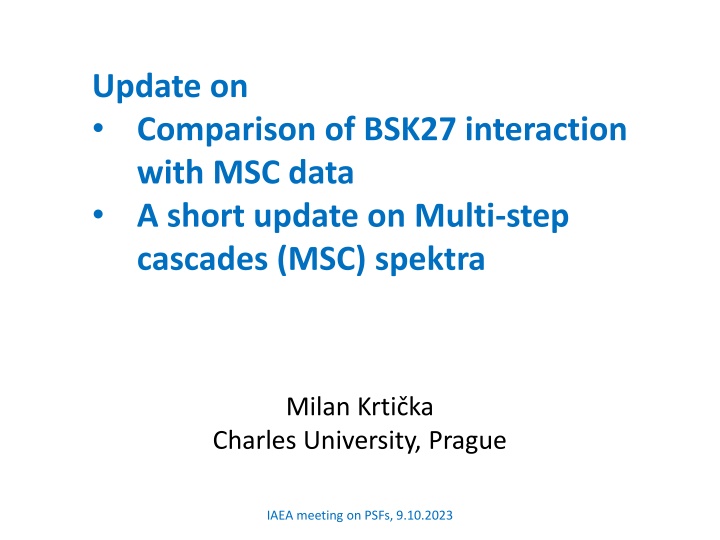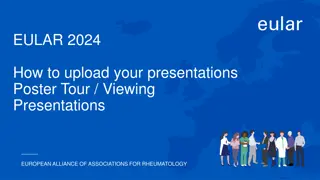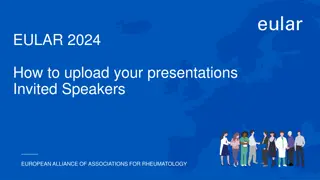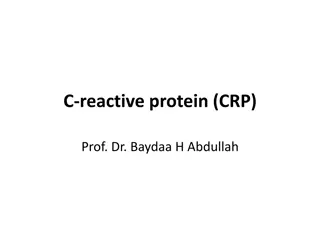
Update on Comparison of BSK27 Interaction with MSC Data and Multi-step Cascades
Explore the comparison of MSC spectra with predictions from the BSK27 Skyrme force, discussing the M1 strength, neutron capturing states, and verification of various models. Spectra measured using specialized detectors at an IAEA meeting provide insights for nuclear physics research.
Uploaded on | 0 Views
Download Presentation

Please find below an Image/Link to download the presentation.
The content on the website is provided AS IS for your information and personal use only. It may not be sold, licensed, or shared on other websites without obtaining consent from the author. If you encounter any issues during the download, it is possible that the publisher has removed the file from their server.
You are allowed to download the files provided on this website for personal or commercial use, subject to the condition that they are used lawfully. All files are the property of their respective owners.
The content on the website is provided AS IS for your information and personal use only. It may not be sold, licensed, or shared on other websites without obtaining consent from the author.
E N D
Presentation Transcript
Update on Comparison of BSK27 interaction with MSC data A short update on Multi-step cascades (MSC) spektra Milan Krti ka Charles University, Prague IAEA meeting on PSFs, 9.10.2023
Comparison of MSC spectra with predictions from BSK27 Skyrme force Test performed for all nuclei used for check of D1M Gogny interaction - M. Krti ka et al., PRC99, 044308 (2019) and PSF review S. Goriely et al., EPJA (2019) 55: 172 - in total 15 nuclei + 168Er, 196Pt published later E1 + spin M1 part from microscopic calculations with the BSK27 parametrization of Skyrme interaction (for details ask Stephane Goriely) E1 strength: rather significantly depends on excitation energy of final state / temperature Smearing, at least for E1 looks rather different from D1M, where the (Lorentzian) smearing width was large (4 MeV) IAEA meeting on PSFs, 9.10.2023
Comparison of MSC spectra with predictions from BSK27 Skyrme force M1 strength: No scissors mode (SM) in BSK27 (no deformation included in calculation only spherical potential considered) Proposed parametrization of SM from SMLO Low-energy enhancement considered in M1 PSF in the form Cx10-9 exp(-E /0.8) [MeV-3], with E in MeV IAEA meeting on PSFs, 9.10.2023
MSC spectra Spectra measured using highly-segmented detectors with relatively good energy resolution large- volume BaF2 detectors used (Almost exclusively) spectra from DANCE detector at Los Alamos Try-and-error based method IAEA meeting on PSFs, 9.10.2023
Spectra of our interest Neutron capturing states Bn+En Multiplicity 1 - 15 Multiplicity = 1 Multiplicity = 2 E 1 200 Intensity (arb. units) 10 Intensity (arb. units) 20 159Gd 0 0 0 Multiplicity = 3 Multiplicity = 4 Multiplicity > 4 50 50 50 E 2 0 0 0 E 3 0 3000 6000 0 3000 6000 0 3000 6000 Energy sum (keV) Energy sum (keV) Energy sum (keV) E 4 Ground state 100 Multiplicity = 1 Multiplicity = 3 Verification of possible validity of various PSF and NLD models based on comparison of observables sum-energy and MSC spectra with predictions of simulations based on statistical model of nucleus Multiplicity = 4 10 50 Intensity (arb. units) 0 0 0 0 3000 6000 Multiplicity = 2 200 Energy (keV) E 1 Multiplicity > 4 10 E 2 E 3 0 0 0 3000 6000 0 3000 6000 E 4 Energy (keV) Energy (keV) Label Energy refers to the deposited energy in a crystal
96,98Mo (spherical nuclei): Reproduction of experimental spectra very reasonable (for appropriately chosen C, which depends on NLD model) Gray area: C = 20; Black hatched: C = 40; NLD: HFB IAEA meeting on PSFs, 9.10.2023
96,98Mo (spherical nuclei): Similar reproduction of experimental spectra as with D1M Gogny interaction (for appropriately chosen C, which depends E1 higher E1 in BSK27 requires larger C) Gray area: D1M C = 30; Black hatched: BSK27 C = 40; NLD: HFB IAEA meeting on PSFs, 9.10.2023
96,98Mo: Negative-parity resonances Gray area: C = 20; Black hatched: C = 40 IAEA meeting on PSFs, 9.10.2023
96,98Mo: Negative-parity resonances Gray area: D1M C = 30; Black hatched: BSK27 C = 40; NLD: HFB IAEA meeting on PSFs, 9.10.2023
112,114Cd (almost spherical): MSC spectra are not perfect, but likely acceptable in majority of cases Often a problem with reproduction of M = 2 and to a lower degree M = 3 (for 114Cd also M = 4) spectra Gray area C = 0; Black hatched C = 10; NLD: HFB IAEA meeting on PSFs, 9.10.2023
Gray area: D1M C = 10; Black hatched: BSK27 C = 10; NLD: HFB IAEA meeting on PSFs, 9.10.2023
112,114Cd (almost spherical): Gray area C = 0; Black hatched C = 10; NLD: HFB IAEA meeting on PSFs, 9.10.2023
Gray area: D1M C = 10; Black hatched: BSK27 C = 10; NLD: HFB IAEA meeting on PSFs, 9.10.2023
156,158Gd: Parameters of SM not fully correct - too high predicted intensity in M = 2 (+ an absence of the strength at 2 3 MeV in M = 4) spectra indicates assumed SM too weak (and/or wrong position). Gray area C = 0; Black hatched C = 10; NLD: HFB IAEA meeting on PSFs, 9.10.2023
156,158Gd: Gray area: D1M, C=10; Black hatched BSK27, C = 10; NLD: HFB IAEA meeting on PSFs, 9.10.2023
Odd Gd: Spectra are acceptably (for a global model) reproduced with C 5 in combination with HFB NLD. Some imperfections likely arise again from too weak SM Spectra likely not very sensitive to SM properties Gray area C = 0; black hatched C = 5; NLD: HFB 157Gd, 1/2+ IAEA meeting on PSFs, 9.10.2023
162,164Dy: Analogous to even Gd isotopes (problem with the SM strength/position) Gray area C = 0; Black hatched C = 10; NLD: HFB IAEA meeting on PSFs, 9.10.2023
Gray area: D1M, C=10; Black hatched BSK27, C = 10; NLD: HFB IAEA meeting on PSFs, 9.10.2023
162,164Dy: Gray area C = 0; Black hatched C = 5; NLD: HFB IAEA meeting on PSFs, 9.10.2023
Gray area: D1M, C=10; Black hatched BSK27, C = 5; NLD: HFB IAEA meeting on PSFs, 9.10.2023
168Er: Much better reproduction than for e-e Gd and Dy isotopes (by chance?). The nucleus seems to be not very sensitive to the checked SM parameters. 4+ resonances reproduced even better Gray area C = 0; Black hatched C = 10; NLD: HFB IAEA meeting on PSFs, 9.10.2023
168Er: Gray area: D1M, C=10; Black hatched BSK27, C = 10; NLD: HFB IAEA meeting on PSFs, 9.10.2023
Odd U (235,237,239U): Similar to e-e Gd isotopes problem with SM position/strength + more complex SM structure Problem typically visible more in M = 3 spectra (while M = 2 spectra look sometimes OK). Gray area C = 0; black hatched C = 10; NLD: HFB IAEA meeting on PSFs, 9.10.2023
Odd U (235,237,239U): Gray area D1M C = 10; Black hatched BSK27 C = 0; NLD: HFB IAEA meeting on PSFs, 9.10.2023
196Pt: Evidently problem with the pygmy resonance (a structure at about 5 MeV), which significantly affects the decay. (Not very surprisingly) no chance to reproduce spectra. Gray area C = 0; Black hatched C = 10; NLD: HFB IAEA meeting on PSFs, 9.10.2023
Some additional checks with the SM strength and position made (motivated by problems visible for some nuclei even-even Gd and Dy, U) maximum cross section 3x larger gives usually worse description maximum cross section 2x larger, energy shifted down by 400 keV improvement in description is scatter achieved for some nuclei but not for others (sometimes probably worse) than with SMLO parametrization IAEA meeting on PSFs, 9.10.2023






















